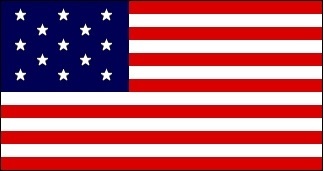My dream is of a place and a time where America will once again be seen as the last best hope of earth. – Abraham Lincoln
With all of the recent news surrounding use of flags and the upcoming anniversary of our country, we thought it would be instructive to review the history related to our national pledge and our flag.
No one knows with absolute certainty who designed the first stars and stripes or who made it. Some believe that Betsy Ross, a Philadelphia seamstress, made the first one. Many also mistakenly believe this to be the first official U.S. flag. The key difference between this flag and the first official U.S.flag is the arrangement of the stars in a circle, contrasted with the staggered arrangement of the official flag.

Until the Executive Order of June 24, 1912, neither the order of the stars nor the proportions of the flag was prescribed. The principal acts affecting the flag of the United States are the following:
- On June 14, 1777 the Continental Congress passed the first Flag Act: “Resolved, That the flag of the United States be made of thirteen stripes, alternate red and white; that the union be thirteen stars, white in a blue field, representing a new Constellation.”

- Act of April 4, 1818 – provided for 13 stripes and one star for each state, to be added to the flag on the 4th of July following the admission of each new state, signed by President Monroe. For this flag, the newly admitted states of Tennessee, Ohio, Louisiana, Indiana and Mississippi were added.

- Executive Order of President Taft dated June 24, 1912 – established proportions of the flag and provided for arrangement of the stars in six horizontal rows of eight each, a single point of each star to be upward.
- Executive Order of President Eisenhower dated August 21, 1959 – provided for the arrangement of the stars in nine staggered rows of stars (five rows of six and four rows of five).

What about the Pledge?
The Pledge of Allegiance was written by the minister Francis Bellamy. It was originally published in The Youth’s Companion on September 8, 1892. Bellamy had hoped that the pledge would be used by citizens in any country.
In its original form it read:
“I pledge allegiance to my Flag and the Republic for which it stands, one nation, indivisible, with liberty and justice for all.”
In 1923, the words, “the Flag of the United States of America” were added. At this time it read:
“I pledge allegiance to the Flag of the United States of America and to the Republic for which it stands, one nation, indivisible, with liberty and justice for all.”
In 1954, in response to the Communist threat of the times, President Eisenhower encouraged Congress to add the words “under God,” creating the 31-word pledge we say today. Today it reads:
“I pledge allegiance to the flag of the United States of America, and to the republic for which it stands, one nation under God, indivisible, with liberty and justice for all.”
Section 4 of the Flag Code states:
The Pledge of Allegiance to the Flag: “I pledge allegiance to the Flag of the United States of America, and to the Republic for which it stands, one Nation under God, indivisible, with liberty and justice for all.”, should be rendered by standing at attention facing the flag with the right hand over the heart. When not in uniform men should remove any non-religious headdress with their right hand and hold it at the left shoulder, the hand being over the heart. Persons in uniform should remain silent, face the flag, and render the military salute.”
As we celebrate the birth of our nation, let us not forget our history. Let us hold fast to instruct our children and defend all that has made this country a great nation.
If we ever forget that we are One Nation Under God, then we will be a nation gone under. – Ronald Reagan





